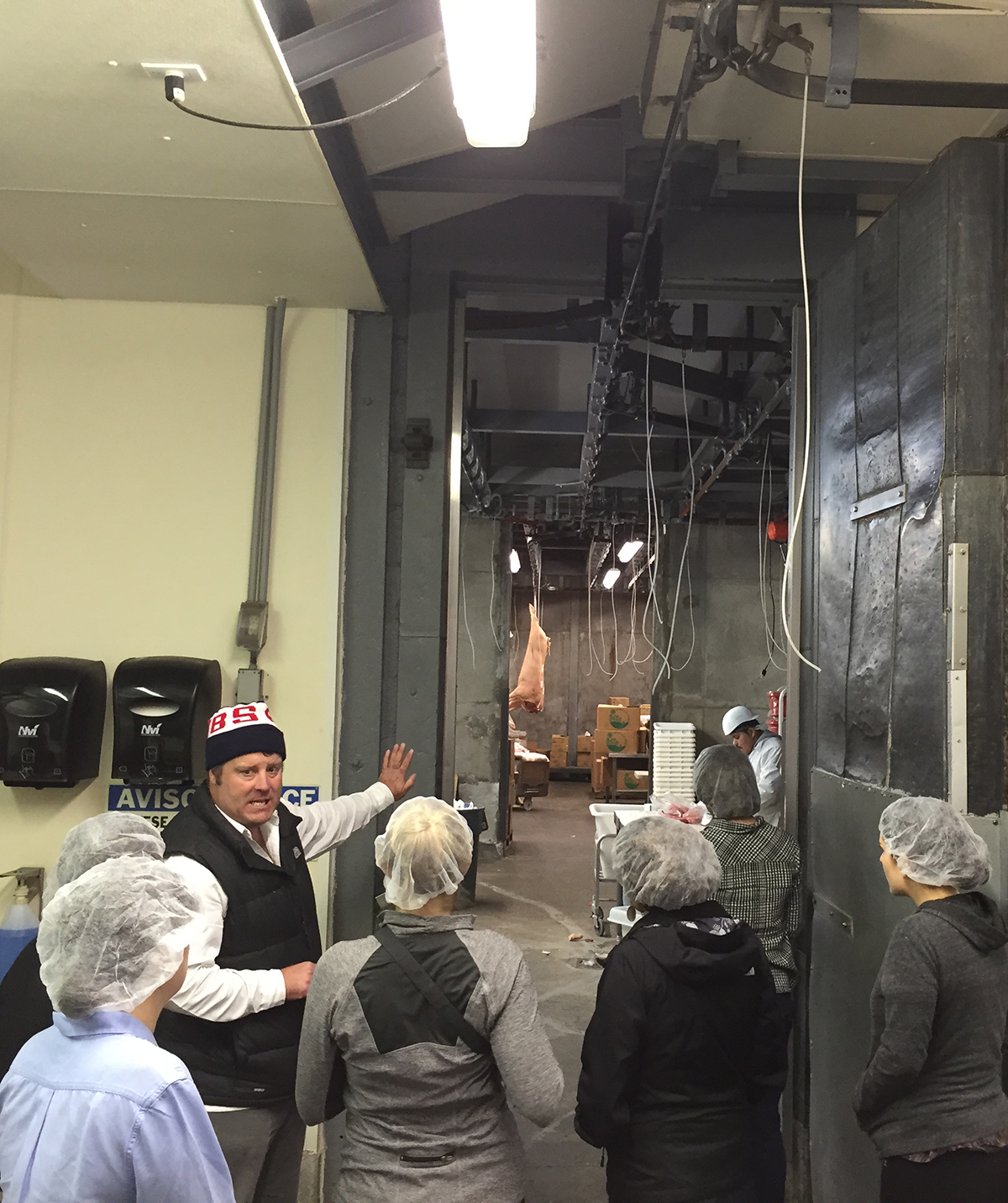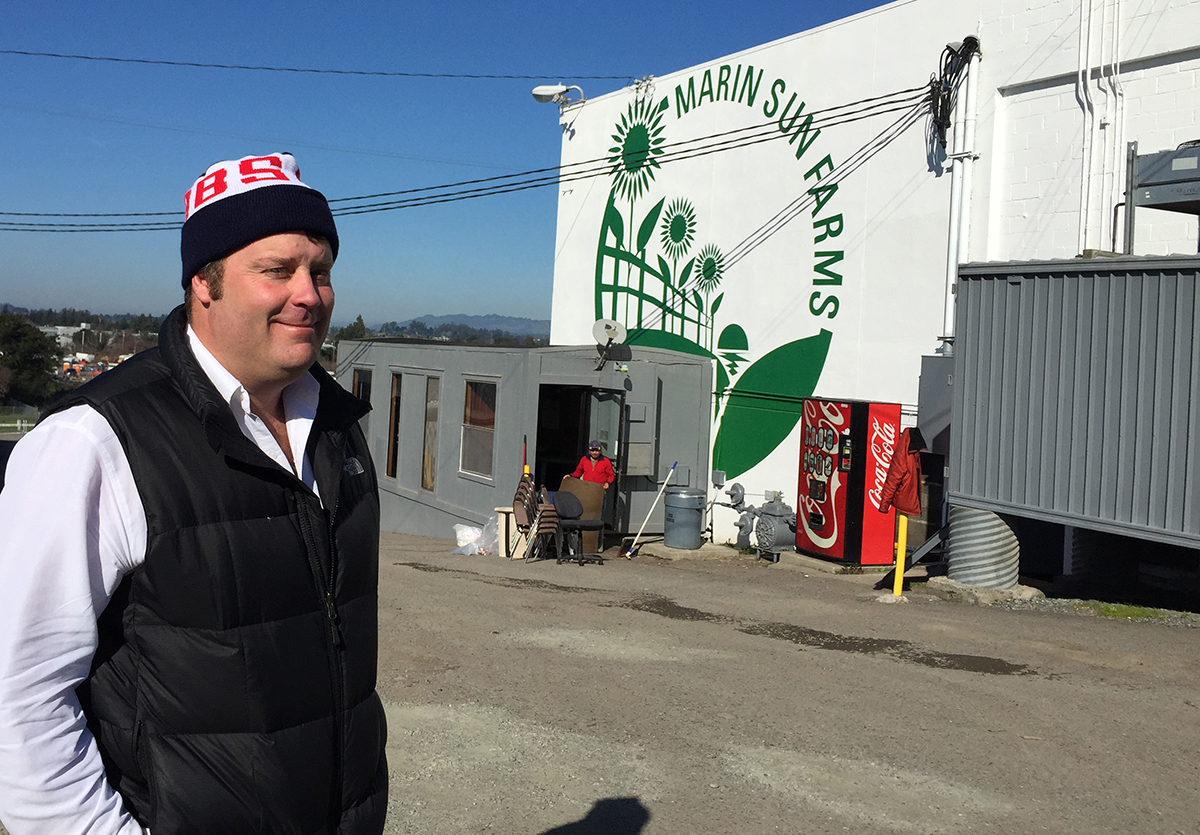Bon Appétiters Visit Slaughterhouse that Saved the Bay Area’s Local Meat Industry

David Evans gives the Bon Appétiters a peek into the cutting room of the Marin Sun Farms slaughterhouse
Standing in black Dansko clogs outside the door of a room where a half-dozen men in hairnets were carving up beef, David Evans told a group of Bon Appétiters how he didn’t set out to become a slaughterhouse operator.
A few years ago, the fourth-generation rancher was the successful owner of Marin Sun Farms in Pt. Reyes, CA — an early Bon Appétit Farm to Fork vendor — and had been expanding his pastured beef, lamb, goat, pork, chicken, duck, and egg business all over the Bay Area. He had dozens of restaurant and institutional customers, a butcher shop in San Francisco, retail markets in Oakland and Point Reyes Station, and a booming community-supported agriculture program.
And then Rancho Feeding Corp., the tiny old Petaluma slaughterhouse that handled most of Northern California’s beef, got shut down by the USDA. Staff there had allegedly been circumventing inspectors and processing sick dairy cows. More than 9 million pounds of beef — covering a year of operations — were recalled, including thousands in storage for such restaurant darlings as BN Ranch, the new grass-finished venture from Bill Niman, the founder of Niman Ranch. Rancho’s elderly owners were in a terrible position, and the future of the slaughterhouse was in doubt. Its demise could have been a fatal blow to one of America’s most dedicated locavore communities.

David Evans
“Slaughter is a scarce resource in this country,” David told the three visiting Bon Appétit Foundation Fellows, Waste Specialist Claire Cummings, Vice President of Strategy Maisie Ganzler, and Director of Communications Bonnie Powell. “Particularly around here — there’s no other slaughterhouse for hundreds of miles. You can’t have local meat without this middle piece. The mission of Marin Sun has always been to build a more sustainable food system, and I knew this was a chance for us to make a big difference.”
David bought the Rancho property and began modernizing its administration; started lamb, goat, and hog processing; and got the facility Certified Organic and Animal Welfare Approved. The Fellows were there to learn more about how an AWA-certified facility differs from the massive slaughterhouses that handle the other 99 percent of the meat supply.
“Slaughter is a scarce resource in this country. Particularly around here — there’s no other slaughterhouse for hundreds of miles. You can’t have local meat without this middle piece.” — David Evans, Marin Sun Farms
David gave the group an hour-long tour (on a day the slaughterhouse line was not running), walking them through each step of what happens from when the animals are dropped off until they end up on the cutting table for the butchering side of the business. The surprisingly small concrete facility was built sometime in the early 1900s, he said; county records are unclear exactly when. While the equipment and systems have been modernized, not that much has changed. His team of skilled workers can handle 40 to 50 cattle per day, or 6 to 9 per hour for a six-hour day, with time for setup and cleaning. They can do up to 100 hogs or sheep/goats per day; the single scalding tank is what’s holding them back from doing more hogs. Just to put those numbers in context, a large slaughterhouse in a meat hub like North Carolina can process 400 cattle per hour. Surprisingly for such a small facility, Marin Sun has three full-time USDA inspectors on-site; given the recent history, clearly the agency is being careful.
David had to get out of the lease on his San Francisco butcher shop and move the carcass fabrication and packing side up to the slaughterhouse to save money. He’s also had to raise harvest fees significantly, which has meant that the low-end dairy cull cows are being trucked elsewhere. “We’re more expensive and I know that,” he says. “We do a great job handling animals, and we pay livable wages. It’s a balancing act. I know what we need to charge to make this operation work.”
Asked if he ever regrets getting himself into this side of the meat business, he thinks for a second. “Well, I sure don’t miss the commute to San Francisco,” he laughs. “And while I didn’t know I would ever end up owning this place, it feels good to be working every day on keeping a piece of scarce infrastructure going.”
Read more at Grist: How the Bay Area’s last slaughterhouse dodged the axe, by HR Smith